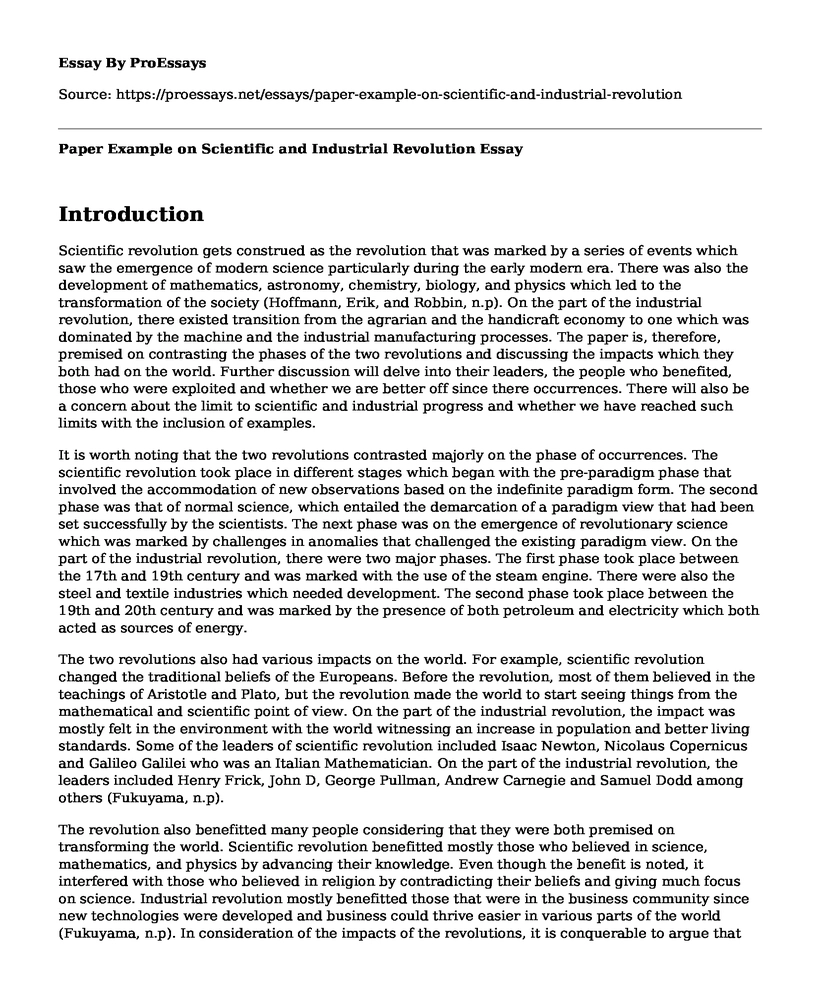Introduction
Scientific revolution gets construed as the revolution that was marked by a series of events which saw the emergence of modern science particularly during the early modern era. There was also the development of mathematics, astronomy, chemistry, biology, and physics which led to the transformation of the society (Hoffmann, Erik, and Robbin, n.p). On the part of the industrial revolution, there existed transition from the agrarian and the handicraft economy to one which was dominated by the machine and the industrial manufacturing processes. The paper is, therefore, premised on contrasting the phases of the two revolutions and discussing the impacts which they both had on the world. Further discussion will delve into their leaders, the people who benefited, those who were exploited and whether we are better off since there occurrences. There will also be a concern about the limit to scientific and industrial progress and whether we have reached such limits with the inclusion of examples.
It is worth noting that the two revolutions contrasted majorly on the phase of occurrences. The scientific revolution took place in different stages which began with the pre-paradigm phase that involved the accommodation of new observations based on the indefinite paradigm form. The second phase was that of normal science, which entailed the demarcation of a paradigm view that had been set successfully by the scientists. The next phase was on the emergence of revolutionary science which was marked by challenges in anomalies that challenged the existing paradigm view. On the part of the industrial revolution, there were two major phases. The first phase took place between the 17th and 19th century and was marked with the use of the steam engine. There were also the steel and textile industries which needed development. The second phase took place between the 19th and 20th century and was marked by the presence of both petroleum and electricity which both acted as sources of energy.
The two revolutions also had various impacts on the world. For example, scientific revolution changed the traditional beliefs of the Europeans. Before the revolution, most of them believed in the teachings of Aristotle and Plato, but the revolution made the world to start seeing things from the mathematical and scientific point of view. On the part of the industrial revolution, the impact was mostly felt in the environment with the world witnessing an increase in population and better living standards. Some of the leaders of scientific revolution included Isaac Newton, Nicolaus Copernicus and Galileo Galilei who was an Italian Mathematician. On the part of the industrial revolution, the leaders included Henry Frick, John D, George Pullman, Andrew Carnegie and Samuel Dodd among others (Fukuyama, n.p).
The revolution also benefitted many people considering that they were both premised on transforming the world. Scientific revolution benefitted mostly those who believed in science, mathematics, and physics by advancing their knowledge. Even though the benefit is noted, it interfered with those who believed in religion by contradicting their beliefs and giving much focus on science. Industrial revolution mostly benefitted those that were in the business community since new technologies were developed and business could thrive easier in various parts of the world (Fukuyama, n.p). In consideration of the impacts of the revolutions, it is conquerable to argue that we are better off based on the various advancement in technology and knowledge that came with them. It is also important to note that scientific and industrial progress has no limits. Discoveries are made every day, and people are still learning new ideas and technology. An example to justify the case is on the various inventions in various disciplines, for example in medicine where new drugs are developed to treat various diseases.
Conclusion
In summary, scientific and industrial revolution both occurred in different phases and brought significant changes to the world. They both changed the manner in which people view things unlike before where the primary dependence was drawn from the philosophers. Some leaders were credited for the existence of these revolutions as evidenced in the paper.
Works Cited
Fukuyama, Francis. Political order and political decay: From the industrial revolution to the globalization of democracy. Farrar, Straus and Giroux, 2014.
Hoffmann, Erik P., and Robbin F. Laird. The Scientific-Technological Revolution and Soviet Foreign Policy: Pergamon Policy Studies on International Politics. Elsevier, 2016.
Cite this page
Paper Example on Scientific and Industrial Revolution. (2022, May 22). Retrieved from https://proessays.net/essays/paper-example-on-scientific-and-industrial-revolution
If you are the original author of this essay and no longer wish to have it published on the ProEssays website, please click below to request its removal:
- Theoretical and Practical Knowledge
- Media and Foreign Policy During the Berlin Wall Events
- Essay Sample on US Policy in Afghanistan, Iran and Iraq
- World War II: The Holocaust - Essay Sample
- Essay Sample on Origins of Earth's Oceans: 6 Billion Yrs Ago
- Essay Example on Ancient Egyptians: Quarrying & Technologies Behind the Pyramids
- Unique American Culture: Religion & Belief Tolerance - Essay Sample







